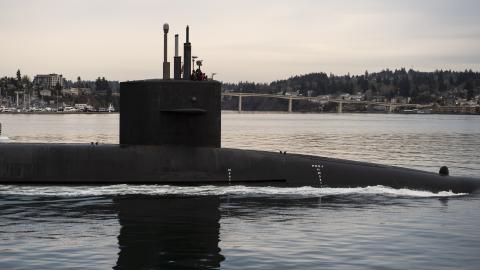In March 2022, President Joe Biden submitted his classified Nuclear Posture Review (NPR) to Congress. In October 2022, the Biden Administration released a public version. The Biden NPR is remarkable in two significant ways. The first is in its continuity with the previous two administrations on the fundamentals of US nuclear deterrence policy, including the very salience of nuclear deterrence and assurance in the modern threat context, the imperative of continued timely modernization of the nuclear triad, and in its declaratory policy. Before becoming president of the United States, and as recently as 2019 on the campaign trail, Joe Biden criticized various aspects of the fundamentals, so his embrace of them as president speaks to their enduring wisdom even, and perhaps especially, in a dynamic international environment wherein analysts assess the threats to US interests will get worse and not better. The second is in the NPR’s simultaneous recognition of the profound changes in the threats to US interests and its choice to reject an initiative to adapt the program of record to improve US deterrence credibility, even after senior military officials warned against its rejection, while also offering none of its own solutions to respond to current challenges. In a sense, the NPR would make more sense had it been written in 2010 before Russia invaded Ukraine twice and before China’s strategic breakout in tandem with its provocations against Taiwan. But as a 2022 document, it is woefully inadequate to provide direction for the current and near future challenges.
The 2022 NPR starts off shaky, citing strategic deterrence as “a top priority mission for the Department of Defense (DoD) and the Nation.”1 One may be tempted to dismiss the characterization of strategic deterrence as a and not the priority as a meaningless oversight. But the 2018 NPR’s language on the subject is so much stronger, one must conclude this change is an intentional softening. The 2018 NPR reads, “Throughout past decades, senior US officials have emphasized that the highest priority of the Department of Defense is deterring nuclear attack and maintaining the nuclear capabilities necessary to do so.”2 Legislators would be warranted to press Pentagon officials on the meaning of this rhetorical softening and ask what other priorities are competing with strategic deterrence.
Even with the inexplicable shaky start, to its credit the Biden NPR sets aside the confusing meaning of the muchvaunted concept of “integrated deterrence,” to assert and embrace the classic and enduring definition of deterrence. It says, “Central to US deterrence strategy is the credibility of our nuclear forces to hold at risk what adversary leadership values most. Effectively deterring—and restoring deterrence if necessary—requires tailored strategies for potential adversaries that reflect our best understanding of their decision-making and perceptions.”3 With this elegant definition, the Biden NPR places itself squarely within the bipartisan consensus since the Cold War. The official US policy reflects a rejection of the notion that nuclear deterrence has a sufficiently high probability of holding when only maintaining a small arsenal of nuclear weapons designed for assured massive retaliation. Instead, US policy is to hold at risk the varied sets of targets based on what each adversary values and possesses. The strategy is tailored for the different contingencies if deterrence fails and seeks to be ready to attempt to convince adversaries to cease hostilities at the lowest levels of violence and destruction possible and return to peace in the case of a deterrence failure. While planning deterrence options and responses if deterrence fails, the Biden NPR embraces a strict counterforce employment guidance that is consonant with the moral and legal strictures outlined in the Department of Defense Law of Armed Conflict in the Law of War Manual. The Biden NPR states that “the DoD Law of War Manual recognizes that ‘[t]he law of war governs the use of nuclear weapons, just as it governs the use of conventional weapons.’ In addition, longstanding US policy is to not purposely threaten civilian populations or objects, and the United States will not intentionally target civilian populations or objects in violation of LOAC.”4 A counterforce employment strategy requires a nuclear deterrence force that is more numerous and precise due to the many military and regime point targets, and requires various delivery systems due to the diverse nature of the targets and how well and differently they are defended.
The Biden NPR also maintains the longstanding US declaratory policy. In 2019, when President Biden was a candidate for the Democratic Party’s presidential nomination, he affirmed his commitment to adopting a No First Use (NFU) policy.5 Thus, there was understandable concern or hope, depending on one’s perspective, that as President, Mr. Biden might move the United States in that direction.6 However, after studying the threat, assessing adversary perceptions, and taking into account ally and partner perspectives and risk, the Biden Administration chose to maintain current policy and to continue to eschew NFU. Moreover, it did not even adopt a Sole Purpose policy, citing an “unacceptable level of risk in light of the range of non-nuclear capabilities being developed and fielded by competitors that could inflict strategic-level damage to the United States and its Allies and partners.” Incongruent with this sound conclusion, the Biden NPR did not relinquish the goal of moving towards a Sole Purpose declaratory statement.7 It raises the question: why is a Sole Purpose policy a worthy goal if it increases unacceptable risks for either a deterrence failure or nuclear proliferation?
The 2022 NPR supports the nuclear modernization plan for all three legs of the triad.8 Of note, as a presidential candidate, Mr. Biden called the W76-2 low-yield submarine launch ballistic missile program reinitiated by the Trump Administration a “bad idea.”9 But the NPR states bluntly that “the W76-2 currently provides an important means to deter limited nuclear use.”10 It also explains that the nuclear weapons partial refurbishment strategy since the Cold War falls short of the modern security demands and thus, like the prior NPRs, commits to investing in a modern nuclear weapons production infrastructure and enterprise.11
Despite the important virtues of the Biden NPR, it fails to provide additional or supplemental capabilities or operational changes to meet the needs and deterrence requirements for the changing nuclear threat environment. The NPR outlines the nature of the nuclear challenges posed by China and Russia, particularly focusing on the way Russia is using nuclear weapons coercively as it carries out its war of conquest against Ukraine. While Russia retains the world’s largest nuclear weapons force, the 2022 NPR assesses that the PRC is amid an ambitious nuclear weapons expansion and is expected to possess “at least” 1,000 deliverable nuclear warheads by the end of the decade.12 Notably, the 2022 DoD report, Military and Security Developments Involving the People’s Republic of China, extends this forecast, assessing that Beijing is likely on track to field a stockpile of 1,500 nuclear weapons by 2035.13
The PRC’s nuclear weapons growth, which the United States is still striving to understand, and Russia’s willingness to threaten to cross the nuclear threshold in a regional conventional war of choice, points to the strong possibility of the wisdom in supplementing current capabilities. But rather than offering suggestions, the Biden NPR doesn’t even retain plans for an important supplemental capability offered by the Trump Administration and supported by senior military officials, the Nuclear Sea-Launched Cruise Missile (SLCM-N). Rejecting SLCM-N, the Biden NPR asserts that the low-yield ballistic missile is sufficient to meet the need identified for the SLCM-N.14
The Biden Administration’s rejection of the SLCM-N goes against the recommendations of numerous senior military officials. In March, General Tod Waters, then commander of US European Command, testified to the House Armed Services Committee that continuing the development of the SLCM-N would be his best military advice.15 In a letter to lawmakers the following month, then STRATCOM chief Admiral Charles Richards wrote in support of the SLCM-N: “The current situation in Ukraine and China’s nuclear trajectory convinces me a deterrence and assurance gap exists. To address this gap, a low-yield, non-ballistic capability to deter and respond without visible generation is necessary to provide a persistent, survivable, regional capability to deter adversaries, assure allies, provide flexible options, as well as complement existing capabilities.”16 And in June, chairman and vice-chairman of the Joint Chiefs of Staff, General Mark Milley and Admiral Christopher Grady, wrote, “We continue to see value in pursuing the nuclear-armed sea-launched cruise missile to deter regional nuclear attack because of its distinct contribution. Nuclear weapons will continue to provide unique deterrence effects that no other element of US military power can replace,” in a joint unclassified letter to certain members of Congress.17 The Biden NPR’s persistent rejection of the prior administration’s analysis about the gaps in our deterrence options and the proposal for a capability that is likely to improve our ability to raise the nuclear threshold when our adversaries appear to be lowering it, especially after Russia’s invasion of Ukraine amid Russian officials’ nuclear saber-rattling, and after US military officials publicly expressed support for the supplemental capability, defies reason.
The Biden NPR also emphasizes the goal of reducing nuclear dangers beyond what deterrence provides towards that end. Among other stated goals, it lists arms control, heading off a costly arms race, non-proliferation, and signaling the desire to reduce the salience of nuclear weapons globally. This is consistent with the Interim National Security Strategic Guidance, which the Biden Administration published in March 2021. The Interim Guidance stated a commitment to, “reduce the role of nuclear weapons in our national security strategy” even as it committed to ensuring our means of strategic deterrence remain “safe, secure, and effective and that our extended deterrence commitments to our allies remain strong and credible.”18
It is unclear how these other goals will be achieved distinct from striving towards increasing the credibility of US nuclear deterrence and ally assurance, including supplementing current capabilities, and whether making progress towards achieving them will realistically strengthen or undermine the ultimate goal—the highest priority—of deterring strategic attack against the United States, our allies, and other vital interests.
Read in the National Institute for Public Policy's Occasional Paper.

















